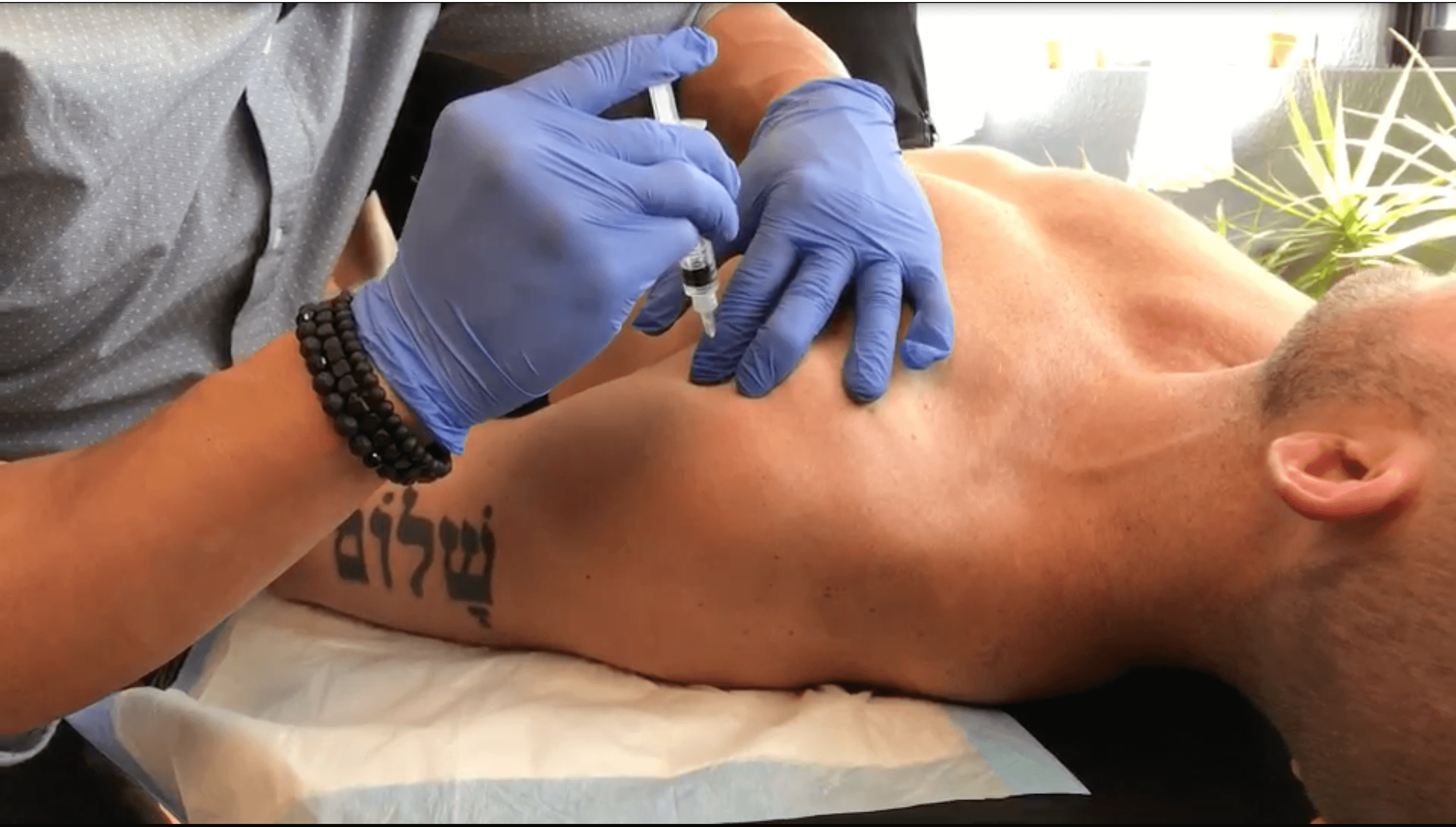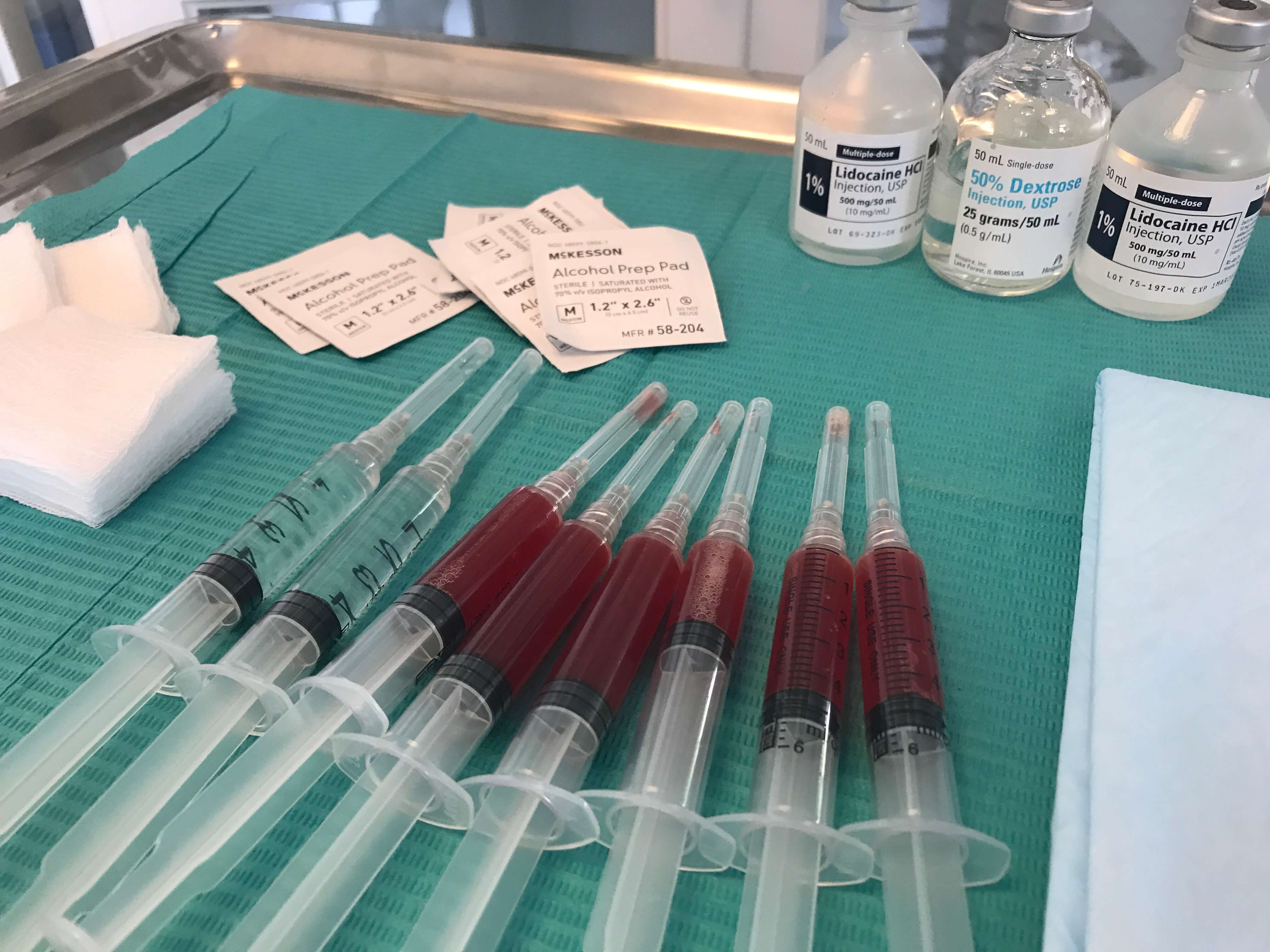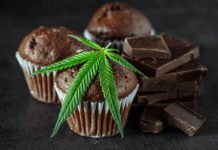
If you’re an athlete or compete in athletic events like marathons, triathlons or cycling – you need to learn more about PRP (Platelet Rich Plasma) Regenerative Injections.
Athletes need to be pain-free to perform at optimal potential and prevent serious injuries. PRP treatments help achieve that.
Here’s some background before we explain how.
What are PRP (Platelet Rich Plasma) Regenerative Injections?
This procedure gained attention when Kobe Bryant visited Germany to receive PRP treatments for a series of knee injuries.
The treatment continues to become more mainstream due to successful clinical results.
PRP (platelet rich plasma) is a component of the blood that contains stem cells and growth factors. These platelets are extracted from a patient’s own blood and activated before being injected back into the injured joint.
The blood is spun down in a centrifuge to separate the red blood cells from the plasma and platelets. The platelets and plasma are then extracted and separated from the red blood cells and spun again to extract the platelet rich plasma. The platelet poor plasma which sits at the top of the vial, when spun down, is discarded.
Once the PRP is extracted and placed in several syringes – the practitioner is ready to inject the damaged connective tissues in which the patient may be suffering their pain and discomfort. This process improves the structural integrity of the joint area by repairing the damaged ligament, tendon or connective tissue.
The PRP activates another healing response through cell differentiation, a process in which cells become specialized and resemble other cells such as a ligament or cartilage cell. This healing response and the repair of damaged connective tissues will potentially reduce pain and improve mobility.
Let’s jump into the positive effects of PRP treatments for athletes.
Treating Reoccurring Injuries And Preventing Re-Injury
Every sport has long seasons, tournaments and a grueling training schedule.
So naturally, every athlete eventually experiences some sort of injury. From a twisted ankle, sprained knee, shoulder stinger to standard bumps and bruises. These injuries heal with time but the serious injuries may never feel 100% healed.
Re-injury is common and a more serious injury may occur because of the body’s compensation or change in biomechanics.
In the treatment of acute injuries (1-3 weeks), it is suggested that the individual use the RICE method on the affected joint. RICE is an acronym for Rest, Ice, Compression, and Elevate. This is a simple way to decrease acute inflammation in a joint. This can be followed by scheduling an appointment to see a trained regenerative medicine doctor to access the structure and function of the joint capsule.
PRP injections are the innovation for injury treatment and prevention.
They can be an important component for treating chronic injuries for improved longevity and ability to play at the highest level. Long-lasting injuries have a domino effect on athletic performance. Players know that if they suffer from a serious injury, their career may be over. New advances in medicine can potentially help athletes recover from injury faster and become even stronger than they were before.
Platelet-rich plasma is that new advancement in medicine that could make all the difference.
The Body’s Incomplete Healing Mechanism
The body’s natural ability is to be a “patch & repair” system. For instance, if an athlete slightly tears a rotator cuff tendon. The body will mount an inflammatory healing cascade (a sequence of enzyme reactions) to bring growth factors and calcium to the affected joint.
After several days, the inflammation subsides, but calcium deposits into the tendon/ligament to try and “patch & repair” the affected connective tissue.
For the next weeks, months and years – the calcium restored area build up “scar tissue” and the athlete loses more and more movement & mobility of the joint. Scar tissue is caused by damage to connective tissues such as ligaments, tendons or muscles. This causes calcium adhesions to build up surrounding the connective tissue causing bony growths, bone spurs and calcium adhesions to muscle tendons.
Physical therapy exercises such as E-stim, ultrasound, icing, foam roller, TENs unit, acupuncture, massage or chiropractic therapy can help but will never repair the damaged ligament or tendon to optimal structure and function.
Treatments that will restore structure and function are:
- PRP (platelet rich plasma) injections
- Prolotherapy injections
- Stem Cell Injections
- Surgical procedures (orthopedic medicine).
These modalities actually go within the joint space (internal), while all of the other interventions are external. Other modalities that aid internal joint healing is nutritional IV therapy. Providing the body with essential vitamins and minerals to support our bodies healing cascade.
This is the ultimate difference in treatment strategies – PRP is actually healing the root cause of physical dysfunction. Crutches, walking boots, stitches, staples or pain medications are not needed post treatment. In fact, PRP patients should stay away from all anti-inflammatory medications or supplements because PRP is actually an inflammatory substance itself (which we want).
Let the body heal thy self!
PRP vs. Cortisone
The difference between PRP and cortisone is the different method of healing.
PRP (platelet rich plasma) regenerative injections aids the body in the healing process by directly injecting stem cells and growth factors to specifically regrow and heal damaged tissues.
PRP injections have an inflammatory effect on the joint space, stimulating the body to send immune cells and growth factors specifically targeting the damaged connective tissues. This leads to improvement in pain severity, structure, and function of the joint.
Cortisone injections have an anti-inflammatory effect. Conventional medicine has come up with modalities to suppress the body’s healing mechanisms and inhibit or block the body’s inflammatory cascades. Cortisone injections block the COX/LOX (cyclooxygenase and lipoxygenase) pathways which cause immune cells to activate and heal the body (joints).
Cortisone injections are beneficial for joint pain relief but will not improve joint structure and function.
It actually degrades the joint capsule. It may deteriorate cartilage, synovial fluid and connective tissues which are essential to joint health. Orthopedic doctors and surgeons recommend a maximum of three cortisone injections into a single joint because of the detrimental effects.
PRP (platelet rich plasma) injections is a non-surgical intervention that doesn’t require a long period of downtime with the inability to move and exercise. It’s suggested that patients and athletes increase movement and activity after one week of rest and recovery. Rehabilitation and strength are essential to joint capsule healing. PRP injections are supportive to the body and push the body to heal quickly and efficiently. Most athletes experience 1-3 days of soreness or a fullness feeling, which then subsides.
Cortisone injections also don’t require long periods of downtime but the “pain-free” joint doesn’t last long. Lasting anywhere between one month to six months on average. This is because cortisone injections are not healing the root cause of the disease or dysfunction. It is the only palliative in care – meaning suppressing the symptoms of pain.
Conclusion
Author Bio: Dr. Jason Phan ND – Founder of LIVV Natural Health a lifestyle brand seeking to optimize health in this modern day society. Specializing in IV Vitamin Therapy, Men’s Health, PRP (Platelet Rich Plasma) Regenerative Injections, PRP Facials, & Living A Life Worth Living.
Terry Asher
Latest posts by Terry Asher (see all)
- Better Family – Product Review Liquid Daily 2 oz - Dec 16, 2024
- Post-Workout Recovery: The Key to Optimal Performance - Nov 25, 2024
- Pre-Workout Supplements – Everything You Need To Know - Nov 18, 2024












If only they were covered by insurance…I got a PRP injection for my arthritic hip. At first I didn’t notice any benefit. But slowly over time I noticed the pain subsiding. It’s been a bout a year and time for another. But shelling out about $1,000 isn’t easy. Someday…
[…] Both of these procedures have demonstrated amazing clinical results and have great potential. This article will focus on stem cells, athletes can learn more PRP here. […]
[…] Both of these procedures have demonstrated amazing clinical results and have great potential. This article will focus on stem cells, athletes can learn more PRP here. […]
Your post is great and meaningful. Thank you for sharing this article. I would like to receive better and better articles.